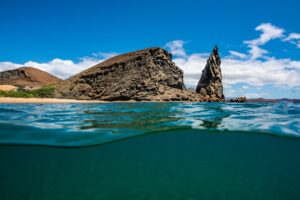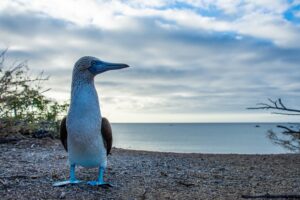Memories. After a family vacation in the Galapagos Islands, children come home with cherished memories to share. For instance, they learn about unique animals’ size, diet, and habitats. While exploring the volcanic islands, they encounter remarkable species, ones they had never even heard of, such as blue-footed boobies. So, back home, they can show their friends how these animals waddle and explain that their blue feet get their color from the nutrients of the fish they eat.
A Galapagos Islands family vacation combines learning opportunities, adventure, and entertainment. While children discover and explore nature, parents find the perfect balance of adventure and relaxation in a remote archipelago. It is a journey where the whole family can create lifelong memories, encounter endemic wildlife, one that can only be seen in the islands, and enjoy quality time together in a remarkable setting.
Located about 600 miles (around 1,000 kilometers) off the coast of Ecuador, the volcanic islands offer visitors the chance to experience unique flora and fauna up close in a completely safe environment. In this way, the islands are the perfect place to teach children to appreciate and respect nature while enjoying land and water activities for the whole family. In this blog, we’ll explore why the Galapagos is the perfect destination for family travel in South America.
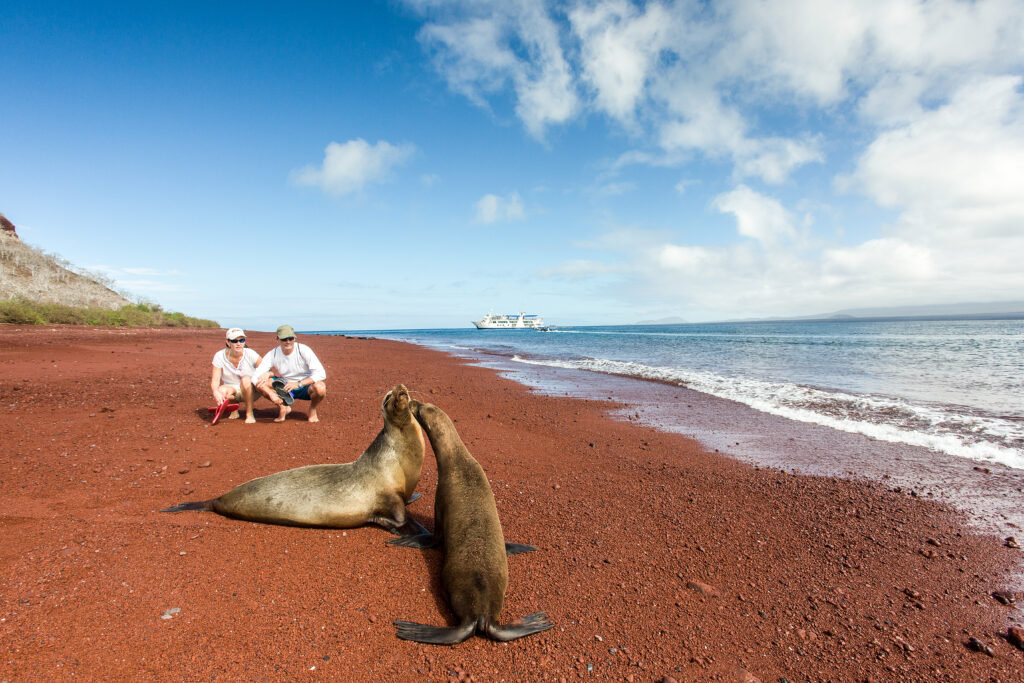
Is Galapagos the Best Family-Friendly Destination in South America?
Yes! The Galapagos Islands are undoubtedly one of the best family-friendly destinations in South America. They are an exceptional choice for families who enjoy adventures, safety and conservation, and activities for all ages.
The remote location of the archipelago is where family members can enjoy unplugged quality time and memorable bonding opportunities in a year-round destination. Snorkeling with sea lions and schools of colorful fish, exploring lava tunnels, and stargazing on an expedition yacht make for lasting memories that strengthen family bonds. So, what makes the Galapagos a friendly destination?
Educational Experience
To say that the Galapagos Islands are a living laboratory of evolution and natural history is not an exaggeration. In 1835, Charles Darwin visited the archipelago and collected reptiles, plants, and birds—including the famous Darwin finches! His trip to the Galapagos helped him shape his theory of natural selection. Moreover, in 1845, he wrote, “We seem to be brought somewhere near to the great fact, that mystery of mysteries – the appearance of the new begins on this earth.”
It’s easy to see that a family vacation to the Galapagos is an opportunity to learn about wildlife, ecology, and the environment. Hiking in the Galapagos Islands feels like stepping onto another planet, with landscapes straight out of a science fiction film. The otherworldly terrain offers an incredible backdrop for exploration and adventure.
As travelers traverse these remote islands, they encounter wildlife in a way that’s truly unique to the Galapagos. It’s a place where your clients can truly learn by doing, discovering the rich biodiversity and natural history of the archipelago. Hiking through these diverse landscapes provides a hands-on education on the wonders of evolution, making every step an opportunity to discover and appreciate the remarkable wildlife that calls the Galapagos home.
Close Encounters with Wildlife
Visiting the Galapagos Islands is an opportunity to encounter various kinds of endemic animals, from giant tortoises to blue-footed boobies and marine iguanas. In the archipelago, many animals have no major predators and are remarkably unafraid of humans. This presents a rare scenario that allows humans to observe different species from a remarkably close distance. It is a chance for kids to see animals they’ve only read about in books or seen in movies or documentaries, making it a truly memorable experience. That said, 97% of the Galapagos is a national park, and the rules are that adventurers must maintain a distance of at least 6 feet (2 meters) from wildlife and never feed the animals.
Adventure and Exploration
The Galapagos National Park permits a variety of activities suitable for all ages, even for children, teenagers, and young adults, as well as seniors who want to relax. Snorkeling, kayaking, and hiking are just a few ways to explore the island’s diverse landscapes and marine life. Naturalist guides tailor activities to match each family’s interests and physical abilities, ensuring everyone can participate.
Quality Family Time
Discovering the archipelago is an ideal bonding experience for children and adults. Because of their remote location, the islands also function as a digital–detox paradise. Thanks to limited connectivity, families can genuinely connect, having the chance to escape the hustle and bustle of digital life and bond as a family.
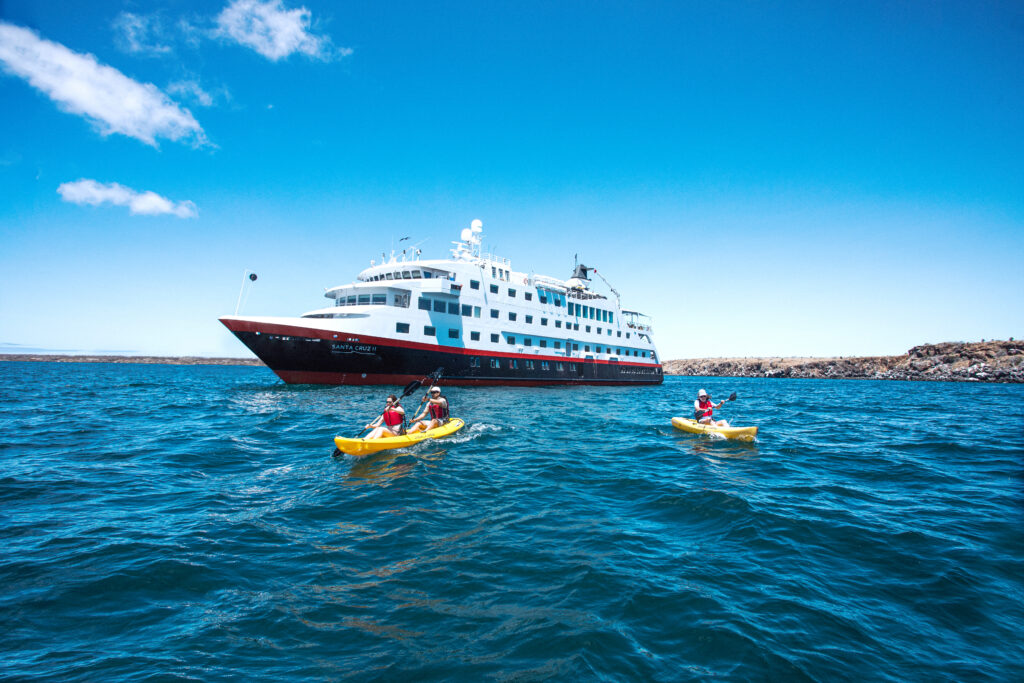
How to Plan the Best Galapagos Island Family Vacation
When you start planning the best Galapagos Islands family vacation for your clients, you need to consider key factors to ensure an enjoyable experience. Here’s a step-by-step guide to help you plan a fantastic family trip to the Galapagos:
When to travel?
Choose the right time to visit. The Galapagos has two main seasons: the hot season (December to May), which tends to be warm and a little humid with brief refreshing showers and lush vegetation, perfect for a terrific beach day, and the dry season (June to December), which tends to be a little cooler and ideal for hiking, birding, and snorkeling, as ocean currents produce upwellings of rich nutrients, resulting in a flurry of underwater activity.
Keep in mind that Galapagos is a year-round destination with an ideal, temperate climate. Each season offers different wildlife experiences, and the best time to visit depends on what the family wants to experience. Here’s a breakdown of the two seasons:
Hot Season (December to May)
- Wildlife Highlights: This season is ideal for observing wildlife activity on land. Because the vegetation is flourishing, there’s an excellent food supply for all the wildlife. Marine and land iguanas are the most colorful. Also, Galapagos giant tortoise’s eggs start to hatch at breeding centers.
- Weather: It’s warmer and more humid during this season. The sea is calmer and has excellent water temperature for snorkeling and swimming. There are occasional light showers, but it’s sunny.
- Landscapes: The vegetation is lush and green, and many plants are in bloom.
Dry Season (June to December)
- Wildlife Highlights: Cooler waters, rich in nutrients, increase marine activity. There’s also an increase in bird activity, as blue-footed boobies and American flamingos start their courtship as part of their mating rituals.
- Weather: This season is cooler and less humid. The air and sea temperatures are lower, which may be more comfortable for some visitors.
- Landscapes: The vegetation is less lush, which makes for better birding opportunities, and the islands have a more arid appearance.
Factors to Consider When Choosing the Time of Year to Visit
Consider what type of wildlife encounters your clients want to experience. For instance, if a multigenerational family is particularly interested in land life, the hot season is the best option. If they’re bird enthusiasts, the dry season is a better choice.
The peak months in the Galapagos tend to be June and July, which coincide with summer vacations in the US and other countries. December is also considered a peak-season month. During these times, the islands are more crowded, and costs may reflect this. On the other hand, the months of May and October are quieter, with lower hotel occupancy rates and smaller crowds.
It’s essential to consider the activities a family wishes to enjoy. Snorkeling, hiking, wildlife observation, and photography are excellent any time of year. So, the best time to plan a Galapagos family vacation may depend on the family’s preferences and what they want to experience during the trip.
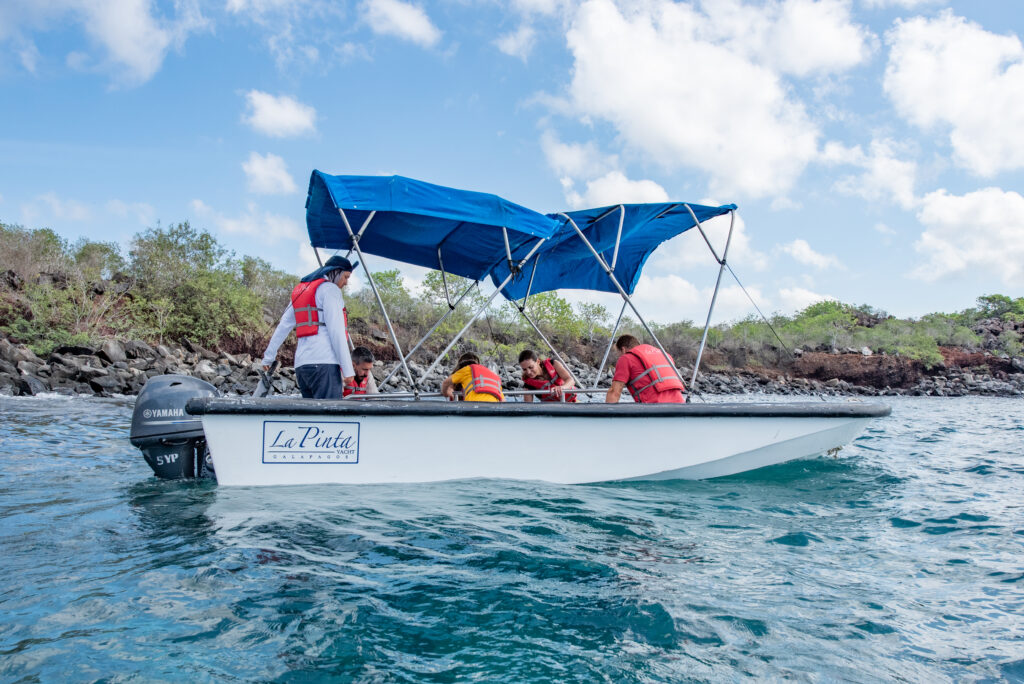
Galapagos with Kids: What age is best?
The best age for children to visit the Galapagos Islands depends on the family’s preferences for activities, plus the specific needs of the children. Visiting the Galapagos is appropriate for most school-aged children, making it an adventure of a lifetime.
If you’re planning a family vacation to the Galapagos for your clients, it’s preferable to choose an age at which children are interested in wildlife and nature. Older children may appreciate the educational aspects of the islands better. Also, consider the physical abilities for some activities, like snorkeling and hiking, which require a certain fitness level and aquatic ability.
While it’s technically possible to visit the Galapagos with infants and toddlers (0-2 years), it may be more challenging due to the organization of traveling with young children. That’s why, if you’re planning to travel with very young children, choose a cruise or land-based stay that caters to families with infants, toddlers, and preschoolers (3-5 years).
A Multigenerational Experience
The Galapagos is the perfect setting for an adventure for family members of almost any age. Outdoor activities, nature discovery, and history make it an exceptional destination for multigenerational travel.
That said, keep in mind that when traveling aboard an expedition vessel, some site visits may involve things like wet landings, where travelers must step out of the dinghy into the water and wade a few steps to reach the shore before beginning the guided activity. Also, hikes may take place along uneven paths, so this may not be the best activity for family members with balance or mobility issues. However, one of the benefits to traveling aboard a multi-guided expedition vessel is that there are alternative options for travelers; for instance, instead of hiking or snorkeling, travelers can enjoy glass bottom boat rides and observe underwater species easily and comfortably.
Between 6 and 11 years is one ideal age range for kids to visit the Galapagos; they’re old enough to participate in various activities while enjoying the unique environment. Elementary-school-aged children can participate in guided excursions, snorkeling activities, and short hikes. Adolescents 12 and older can explore the archipelago via snorkeling, hiking, and kayaking activities. They can also appreciate the scientific and conservation aspects of the archipelago and learn from naturalist guides.
Travel Tips and Special Considerations for Kids
Planning a Galapagos family vacation is a life-enriching experience. However, regarding kids, there are some considerations and special restrictions.
Entry Requirements
The Galapagos has strict entry requirements for all its visitors to protect the delicate ecosystem and wildlife. For children traveling, here’s what you need to keep in mind:
- Visitor Permit: All travelers to the Galapagos, including children, require a visitor permit. The Galapagos National Park issues the permit, and you need to present it upon arriving in the Galapagos.
- Valid identification card or passport: Travelers’ IDs must have an expiration date no earlier than six months before the date of arrival in Ecuador.
- Visa: Check whether Ecuador requires travelers to have a valid visa for entry. Visas are not required for US and Canadian citizens, as well as most Europeans.
- Baggage inspection: All baggage is inspected upon arrival. The review is a safety precaution to avoid introducing harmful substances and materials to the islands; these may include fruits, seeds, flowers, and any living plants. Also, pets are not allowed.
Booking Flights
The Galapagos Islands have two main airports: Seymour Airport on Baltra Island and San Cristobal Airport on San Cristobal Island. Consider the itinerary when planning your clients’ Galapagos Islands family vacation.
When you book a flight to the Galapagos, travelers will first fly to Ecuador’s mainland. International flights connect to airports in Quito, the capital, or Guayaquil. Once your clients arrive in Ecuador, they must fly to Seymour Airport or San Cristobal Airport.
Keep in mind that airlines have their policies regarding child airfares. Some offer discounts for infants (under 2 years old), while others charge a reduced fare for children (2-11 years old). When booking, confirm the airline’s policies.
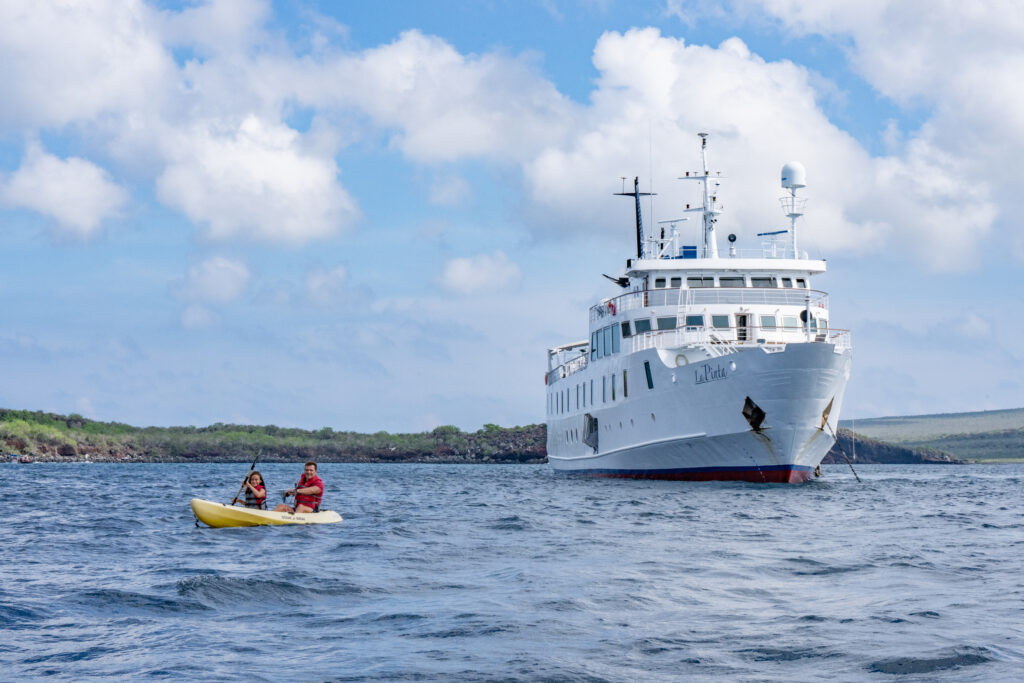
Top 5 Family-Friendly Activities
The archipelago offers unique wildlife, stunning landscapes, and unforgettable adventures. Whether your clients are traveling with kids or teens, there’s an abundance of family-friendly activities to keep everyone engaged and amazed.
1. Snorkeling
Snorkeling with sea lions is a dream come true. These playful animals are curious creatures who love to glide and twist alongside snorkelers. Kids can join in on the fun with proper supervision and suitable gear.
2. Kayaking
Exploring the Galapagos from a kayak is a family-friendly adventure. Paddle through calm bays and secluded coves, looking for marine life beneath the clear waters. Metropolitan Touring expedition cruises and the Finch Bay Galapagos Hotel offer guided kayaking excursions for all ages.
3. Hiking
The Galapagos Islands are home to a diverse range of landscapes, from volcanic craters to lush highlands. Family-friendly hiking trails offer the opportunity to explore these natural wonders. With the guidance of expert naturalists, families can learn about the islands’ geology, unique plant species, and the intriguing history of volcanic eruptions.
4. Wildlife Observation
Giant tortoises are the first thing that come to mind when considering the Galapagos Islands. They are a symbol of the islands’ remarkable biodiversity. Family tours to the Charles Darwin Research Station on Santa Cruz Island provide a close encounter with these incredible creatures.
Also, the Galapagos is a paradise for bird enthusiasts, and watching the quirky blue-footed boobies perform their entertaining mating dances is a highlight. Observing frigatebirds, albatrosses, and other birds is an enriching experience for kids and teens interested in wildlife.
The Galapagos Islands are home to an abundance of native and endemic species. This is one of the big reasons behind our BIG 15 list of iconic species, a compilation of must-see animals separated by island throughout the archipelago.
5. Glass-bottom boat ride
A glass-bottom boat tour allows families to discover vibrant fish, sea turtles, rays, etc. The clear waters provide a window to underwater life, making it an experience for children and adults alike.
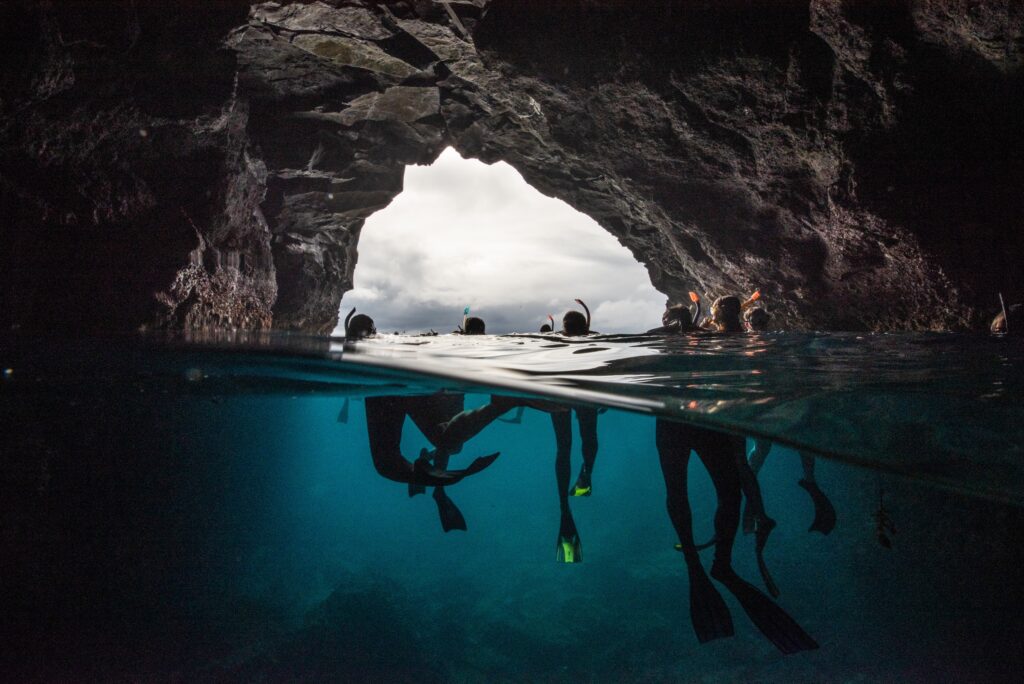
Insider Recommendations for a Safe Galapagos Family Travel
Galapagos is considered the safest destination in South America. The islands are known for their unique and controlled environment, with strict regulations to protect the delicate ecosystems, wildlife, and the safety of visitors.
Galapagos is a Safe Haven for Nature Enthusiasts
Sea lions resting on piers, jetties, and benches are a common sight in the Galapagos. They like to bask in the sun, occasionally stretching or yawning as they sleep. Curious sea lions also like to swim along snorkelers and divers. Their presence in and around human-inhabited areas is a testament to the harmonious coexistence between wildlife and people in this part of the world.
It also shows how safe Galapagos is. Many residents, Ecuadorians, and international expats inhabit the islands. The human population resides on four inhabited islands: Santa Cruz, San Cristobal, Isabela, and Floreana in safe, relatively small towns, with high employment rates, thanks to a thriving ecologically-sensitive tourism industry.
Controlled Tourism
The Galapagos National Park encompasses the entire archipelago, which consists of 19 main islands, smaller islets, and surrounding marine areas. It covers terrestrial and aquatic ecosystems. 97% of the Galapagos is designated as a national park. It was established in 1959, becoming Ecuador’s first national park. Also, in 1978, it was declared a UNESCO World Heritage Site.
The islands are known for their strict regulations regarding tourism. The Ecuadorian government, in collaboration with conservation organizations, has implemented stringent controls to safeguard the archipelago’s delicate ecosystems. A limited number of visitors can explore the islands annually, minimizing the environmental impact and ensuring a responsible and sustainable travel experience. This control over tourism helps maintain the islands’ safety and preserves their pristine condition. As a result, fewer tourists mean more space for family exploration.
Wildlife Protection
Galapagos is home to some of the world’s most unique and diverse wildlife. Animals and birds have evolved without natural predators, which makes them unafraid of humans. As a result, visitors enjoy a safe environment for families to observe and appreciate them up close, following the park’s regulations.
Multiple Guides Aboard
The Galapagos National Park strictly requires that a Park-certified naturalist guide accompany visitors at all times when exploring the islands’ unique visitor sites. Their company ensures the preservation of flora and fauna, as well as educating visitors on the importance of their conservation.
Medical Officer on Board
Each Metropolitan Touring expedition vessel and cruise has an onboard medical officer dedicated to health-related issues that may arise during the trip. These medical officers ensure the safety and well-being of passengers and crew members while exploring the remote and pristine environments of the Galapagos. It’s strongly recommended that guests obtain travel insurance to assist them with additional coverage should they need it in case of an accident or medical emergency.
Galapagos National Park Regulations
Discovering the Galapagos Islands is a thrilling adventure for families, but it’s essential to prioritize safety while enjoying this unique destination. The Galapagos National Park enforces strict rules to protect the islands, including maintaining a safe distance from wildlife, staying on designated paths, and following guidelines for water-based activities such as snorkeling and diving.
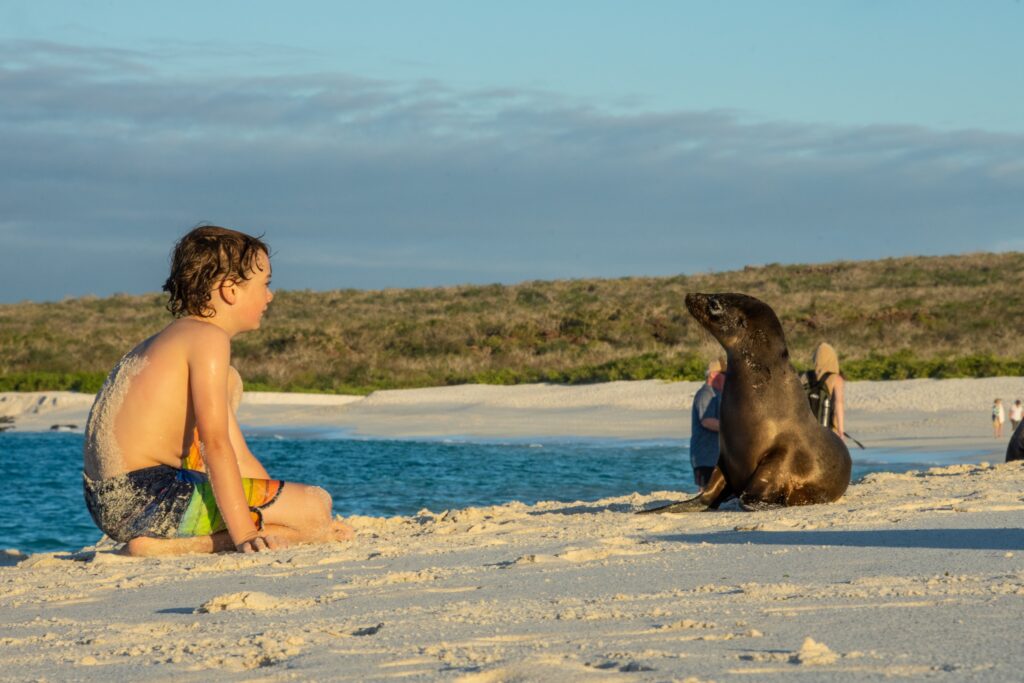
A vacation in the Galapagos Islands is a journey filled with unforgettable experiences, education, and adventure for all ages. While parents find the perfect balance between exploration and relaxation, children return home with cherished memories of encounters with unique wildlife in this remote archipelago.
The Galapagos Islands are undeniably one of South America’s safest and premier family-friendly destinations. The educational opportunities, close encounters with wildlife, and a wide range of adventure activities make it an exceptional choice for families. The islands offer the chance to explore a living laboratory of evolution and natural history, just as Charles Darwin did in 1835.
The archipelago’s unique environment, strict regulations, and controlled tourism ensure the safety and preservation of its delicate ecosystem. Therefore, children of various ages can enjoy the Galapagos. Families can create multigenerational memories in this unique environment, exploring together and learning from expert naturalist guides.

